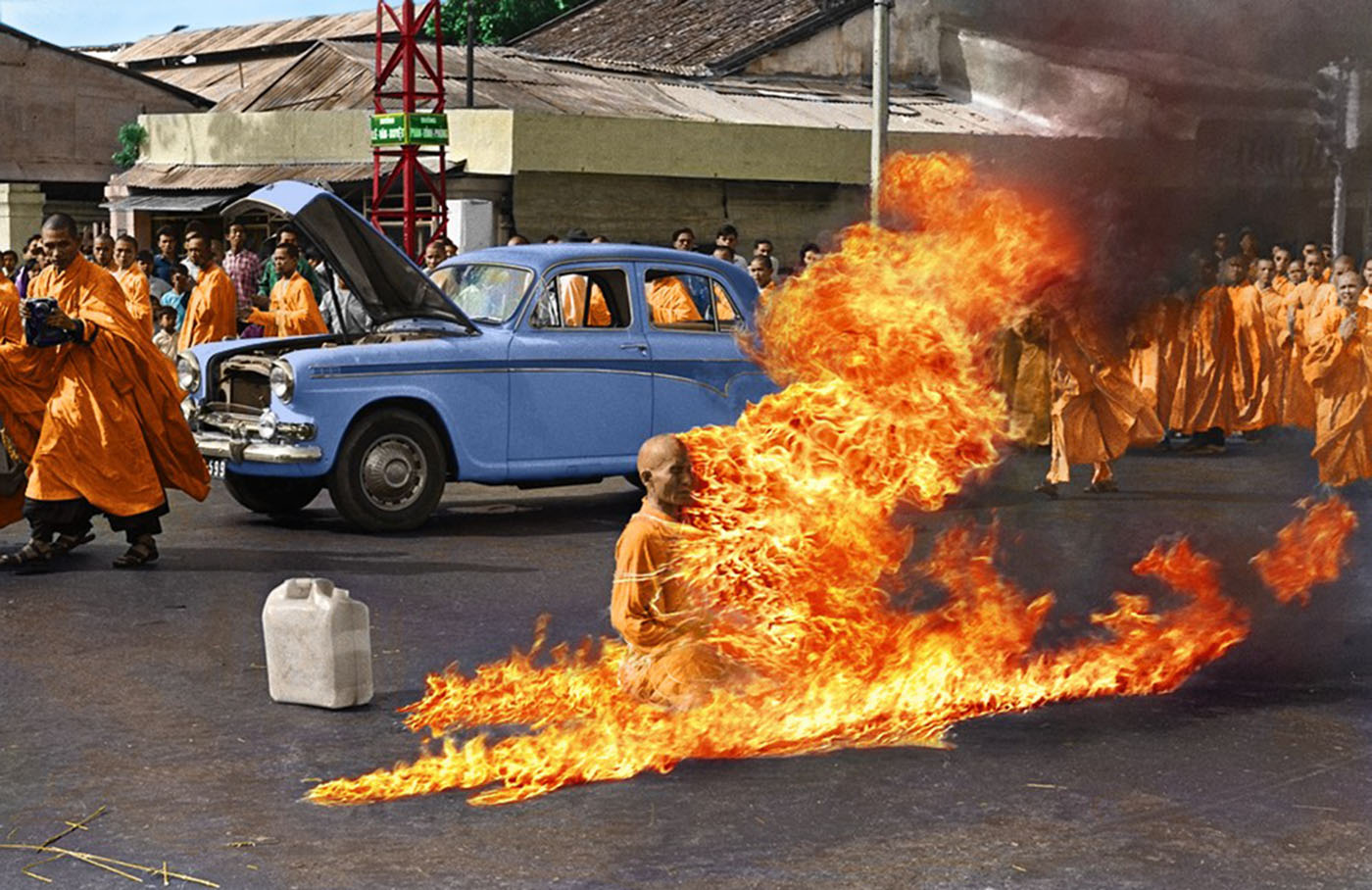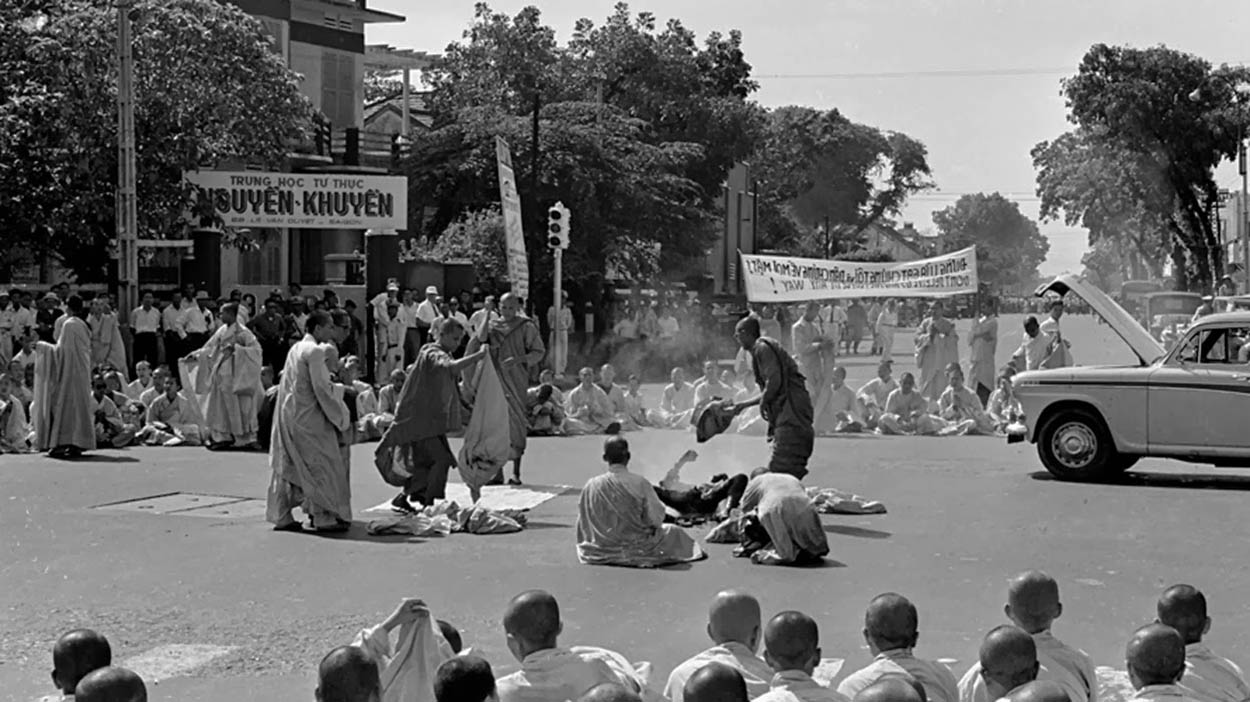Ah Shit Here We Go Again Buddist Monk

In June of 1963, Vietnamese Mahayana Buddhist monk Thích Quang Duc burned himself to expiry at a busy intersection in Saigon.
In June of 1963, Vietnamese Mahayana Buddhist monk Thích Quang Duc burned himself to death at a decorated intersection in Saigon. He was attempting to show that to fight all forms of oppression on equal terms, Buddhism besides, needed to have its martyrs.
John F. Kennedy said in reference to a photo of Duc on fire: "No news picture in history has generated and then much emotion around the world equally that 1". Photographer Malcolm Browne captured the scene in Saigon for the Associated Printing, and the stark black and white image quickly became an iconic visual of the turbulent 1960s.
The self-immolation was done in protest of the Southward Vietnamese Diem regime'due south pro-cosmic policies and discriminatory Buddhist laws. In particular, this was a response to the banning of the Buddhist flag, just 2 days later on Diem had held a very public ceremony displaying crosses; before in his rule, he had dedicated Vietnam to Jesus and the Catholic Church building.
The growing resentment of Buddhists under Diem was ane of the underlying issues of South Vietnam and eventually led to a coup to put in place a leader who would non alienate Buddhists, who made up 70-90% of Vietnam'south population.
Buddhist discontent erupted following a ban in early May on flight the Buddhist flag in Huế on Vesak, the birthday of Gautama Buddha. A large crowd of Buddhists protested the ban, defying the government by flying Buddhist flags on Vesak and marching on the government dissemination station. Government forces fired into the crowd of protesters, killing nine people.

"No news picture in history has generated so much emotion around the earth as that one". (Colored version).
On x June 1963, U.South. correspondents were informed that "something of import" would happen the following morning time on the route outside the Cambodian embassy in Saigon.
Nigh of the reporters disregarded the message since the Buddhist crunch had at that indicate been going on for more than a month and the next 24-hour interval merely a few journalists turned up, including David Halberstam of The New York Times and Malcolm Browne, the Saigon bureau chief for the Associated Press.
Duc arrived equally function of a procession that had begun at a nearby pagoda. Around 350 monks and nuns marched carrying denouncing the Diem regime and its policy towards Buddhists.
The act occurred at the intersection of Phan Đình Phùng Boulevard and Lê Văn Duyệt Street a few blocks Southwest of the Presidential Palace (now the Reunification Palace). Duc emerged from the car along with two other monks. One placed a absorber on the road while the second opened the body and took out a five-gallon petrol can.
As the marchers formed a circumvolve effectually him, Duc calmly sat down in the traditional Buddhist meditative lotus position on the cushion. A colleague emptied the contents of the petrol container over Duc head.
Duc rotated a string of wooden prayer beads and recited the words Nam mô A di đà Phật ("homage to Amitābha Buddha") earlier hitting a match and dropping it on himself. Flames consumed his robes and flesh, and black oily smoke emanated from his burning body.

Thich Quang Duc is doused with gasoline while calmly sitting downwardly in the traditional Buddhist meditative lotus position.
Quang Duc'due south terminal words before his self-immolation were documented in a letter he had left:
"Before closing my eyes and moving towards the vision of the Buddha, I respectfully plead to President Ngo Dinh Diem to take a mind of compassion towards the people of the nation and implement religious equality to maintain the forcefulness of the homeland eternally. I phone call the venerables, reverends, members of the sangha and the lay Buddhists to organize in solidarity to make sacrifices to protect Buddhism".

Flames consumed his robes and flesh, and black oily fume emanated from his burning torso.
David Halberstam wrote:
"I was to encounter that sight once again, merely once was enough. Flames were coming from a human existence; his body was slowly withering and shriveling up, his caput blackening and charring. In the air was the olfactory property of burning man flesh; human beings burn surprisingly rapidly.
Behind me, I could hear the sobbing of the Vietnamese who were now gathering. I was too shocked to cry, too confused to take notes or ask questions, too bewildered to even recall… As he burned he never moved a muscle, never uttered a audio, his outward sophistication in abrupt contrast to the wailing people around him".

Many of the monks and nuns, as well equally some shocked passersby, prostrated themselves before the burning monk.
The spectators were generally stunned into silence, but some wailed and several began praying. Many of the monks and nuns, too equally some shocked passersby, prostrated themselves earlier the called-for monk.
In English language and Vietnamese, a monk repeated into a microphone: "A Buddhist priest burns himself to death. A Buddhist priest becomes a martyr".

Once the fire subsided, a group of monks covered the smoking corpse with yellow robes.
Later approximately ten minutes, Duc'southward trunk was fully immolated and information technology eventually toppled backward onto its back. In one case the fire subsided, a grouping of monks covered the smoking corpse with yellow robes, picked it upward, and tried to fit it into a bury, but the limbs could not be straightened and 1 of the artillery protruded from the wooden box as he was carried to the nearby pagoda in central Saigon.
Quang Duc's body was re-cremated during the funeral, but Duc heart remained intact and did not burn. Information technology was considered to exist holy and placed in a glass beaker at Xa Loi Pagoda. The intact heart relic is regarded equally a symbol of compassion.
Despite the shock of the Western public, the exercise of Vietnamese monks self-immolating was non unprecedented. Instances of cocky-immolations in Vietnam had been recorded for centuries, usually carried out to honour Gautama Buddha.
Photographs taken by Malcolm Browne of the cocky-immolation quickly spread across the wire services and were featured on the front pages of newspapers worldwide.
The cocky-immolation was afterward regarded as a turning betoken in the Buddhist crunch and a critical betoken in the collapse of the Diem government. Malcolm Browne won a Pulitzer Prize for his photograph of the monk'south decease.
(Photograph credit: Malcolm Browne / The colorized version made by u/mygrapefruit.)
Source: https://rarehistoricalphotos.com/the-burning-monk-1963/
0 Response to "Ah Shit Here We Go Again Buddist Monk"
Post a Comment